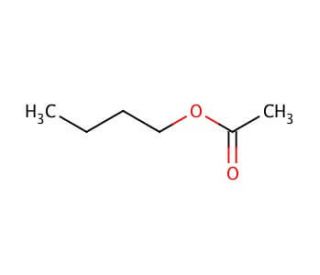

Butyl acetate (CAS 123-86-4)
QUICK LINKS
Butyl acetate is a versatile ester widely used in research due to its effective solvent properties and unique chemical interactions. It readily dissolves various organic compounds, making it essential in applications like chromatographic analysis, where it′s often used as an elution solvent. The solvent′s capacity to dissolve a broad spectrum of materials aids in the extraction and separation of chemical compounds for further analysis. In environmental chemistry studies, butyl acetate is commonly used to simulate the behavior of volatile organic compounds (VOCs) in atmospheric dispersion models, contributing to a better understanding of VOC impact on air quality. It also serves as a standard for calibrating analytical instruments used in VOC detection. Furthermore, butyl acetate has been employed in coatings research to investigate the dynamics of film formation and solvent evaporation. Its evaporation rate provides insight into solvent evaporation kinetics and its impact on polymeric film properties. In addition, it has facilitated research into the adhesive properties of resins and polymers due to its role in modifying surface tension and viscosity. By understanding how butyl acetate interacts with various resins, researchers can develop formulations with optimized performance characteristics for coatings and adhesives.
Butyl acetate (CAS 123-86-4) References
- Biodegradation of xylene and butyl acetate using an aqueous-silicon oil two-phase system. | Gardin, H., et al. 1999. Biodegradation. 10: 193-200. PMID: 10492887
- Ocular and nasal trigeminal detection of butyl acetate and toluene presented singly and in mixtures. | Cometto-Muñiz, JE., et al. 2001. Toxicol Sci. 63: 233-44. PMID: 11568367
- Adsorption of butyl acetate in air over silver-loaded Y and ZSM-5 zeolites: experimental and modelling studies. | Bhatia, S., et al. 2009. J Hazard Mater. 163: 73-81. PMID: 18649998
- Potential biofuel additive from renewable sources--Kinetic study of formation of butyl acetate by heterogeneously catalyzed transesterification of ethyl acetate with butanol. | Ali, SH., et al. 2011. Bioresour Technol. 102: 10094-103. PMID: 21908187
- In vitro growth of Colletotrichum gloeosporioides is affected by butyl acetate, a compound produced during the co-culture of Trichoderma sp. and Bacillus subtilis. | Emanuel, RV., et al. 2020. 3 Biotech. 10: 329. PMID: 32656062
- Comprehensive evaluation for the one-pot biosynthesis of butyl acetate by using microbial mono- and co-cultures. | Lv, Y., et al. 2021. Biotechnol Biofuels. 14: 203. PMID: 34656153
- Metabolic engineering of Escherichia coli for efficient biosynthesis of butyl acetate. | Ku, JT., et al. 2022. Microb Cell Fact. 21: 28. PMID: 35193559
- Production of C3 -C6 Acetate Esters via CO Electroreduction in a Membrane Electrode Assembly Cell. | Zhou, Y., et al. 2022. Angew Chem Int Ed Engl. 61: e202202859. PMID: 35536257
- Butyl Acetate Pyrolysis and Combustion Chemistry: Mechanism Generation and Shock Tube Experiments. | Dong, X., et al. 2023. J Phys Chem A. 127: 3231-3245. PMID: 36999979
- Study on Thermal Risk of Coal-Based Activated Carbon after Adsorbing Acetone, Cyclohexane, and Butyl Acetate. | Wang, L., et al. 2023. ACS Omega. 8: 33883-33890. PMID: 37744836
Ordering Information
| Product Name | Catalog # | UNIT | Price | Qty | FAVORITES | |
Butyl acetate, 1 ml | sc-214637 | 1 ml | $20.00 | |||
Butyl acetate, 5 ml | sc-214637A | 5 ml | $77.00 |
